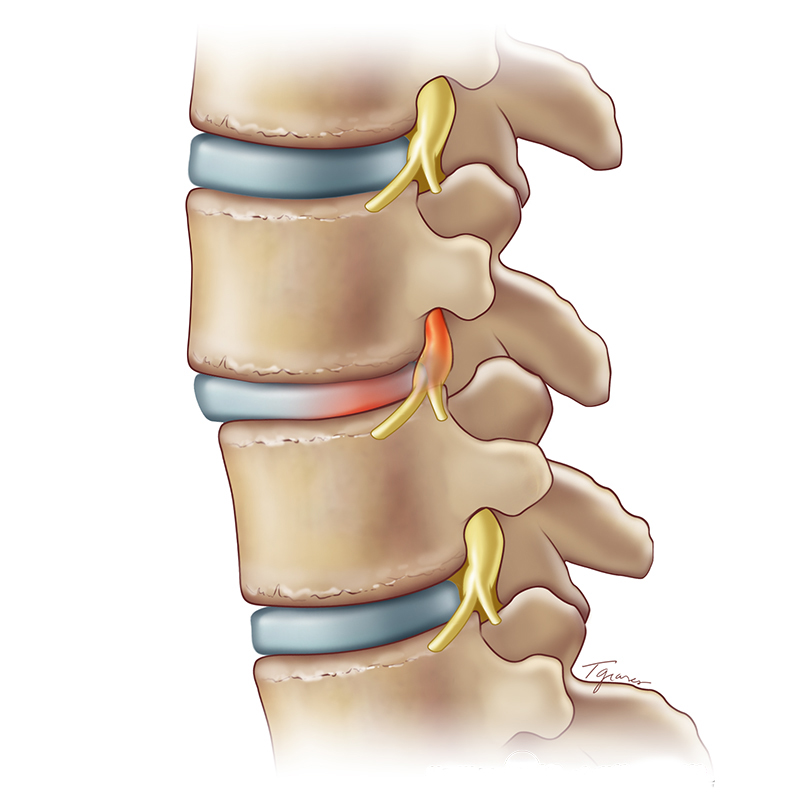Spondylolisthesis
What is Spondylolisthesis?
The spine is made of 33 bones called vertebrae. When one of these bones slips forward on the adjacent neighbouring vertebra, this is called spondylolisthesis. This condition can cause back and leg pain, as well as other symptoms. Spondylolisthesis may be hereditary, or it may be the result of stress placed on the spine. It can also be due to spinal degeneration. This condition can gradually cause a deformity of the lower spine, and it can narrow the vertebral canal.
What are the different types of Spondylolisthesis?
- Dysplastic spondylolisthesis occurs when a defect in the facet allows the vertebra to slip forward. This type is congenital, meaning the patient is born with it.
- Isthmic spondylolisthesis occurs when there is a defect in a portion of the vertebra called the pars interarticularis. This condition can be caused by repetitive trauma, and it is more evident in athletes who may hyperextend, like football linemen or gymnasts. However, if there is no slippage of a vertebra, the patient has spondylolysis. Isthmic spondylolisthesis can be further divided into three categories:

Type II A – Often called Lytic or stress spondylolisthesis, this type is likely caused by repeated micro-fractures due to hyperextension. This type is more common in males and is called a “stress fracture” of the pars interarticularii.
Type II B – Likely also occurs from micro-fractures in the pars interarticularii. This type is different from the preceding type in that the pars interarticularii stay intact, but stretch out as new bone fills in the fractures.
Type II C – Caused by an acute fracture of the pars interarticularii. This type is very rare, and may require nuclear imaging to firmly establish diagnosis.
- Degenerative spondylolisthesis is caused by arthritic changes in the vertebral joints due to cartilage degeneration. This condition is more common in older patients.
- Traumatic Spondylolisthesis is caused by injury or direct trauma to the vertebrae. In this type of Spondylolisthesis, a fracture of the lamina, pedicle or facet joints lets the front part of the vertebra to slip forward.
- Pathologic Spondylolisthesis occurs when the bone is made structurally weak due to a disease, like a tumour or another bone disorder.
What are the symptoms of Spondylolisthesis?
Lower back pain is the most common symptom of spondylolisthesis. The pain is often made worse by bending forward and relieved by bending back. The amount of pain experienced does not correlate to the degree to which the vertebra has slipped. Leg pain may also be felt, which may be due to narrowing of the space where the nerves leave the spinal canal.
How is Spondylolisthesis diagnosed?
Clinical history -Half of patients with spondylolisthesis will associate the onset of their symptoms with an injury. Often a patient will lay the groundwork for the injury earlier on in life by developing a lesion. This lesion may not develop into spondylolisthesis until much later in life.
Physical examination -There is usually little deformity detectable, and range of motion is not usually impacted. Often, tightness of the hamstring muscles is the first physical sign of spondylolisthesis. Back pain may occur at irregular intervals, particularly when arching the back. If a nerve is being pinched by spondylolisthesis, a patient may display symptoms similar to those seen with a herniated disc, including muscle weakness of the legs, numbness or tingling in the feet and leg pain.
What is the treatment of Spondylolisthesis?
- Treatment varies, depending on if the type of slip, the patient’s age and symptoms, and whether pressure is being put on nerves. For those whose nerves are not affected by the vertebral slippage, treatment starts with non-surgical treatments like medication and physical therapy. Bracing may also be recommended. If symptoms are manageable and the slip is small, the treatment will likely be observation. Activity restrictions may be necessary for children, like abstaining from certain sports.
If the slip is more severe or symptoms of nerve compression are present, surgery may be recommended. Surgeries for this condition include spinal decompression, where bone is removed to make room for the nerve being compressed, or spinal fusion. These surgeries are often done at the same time.
Contact
FILL IN THE FORM
FOR APPOINTMENT
For Emergency
We Are Open Always 24 hrs | 365 Days
Call: 8657500555 | 8657500666
